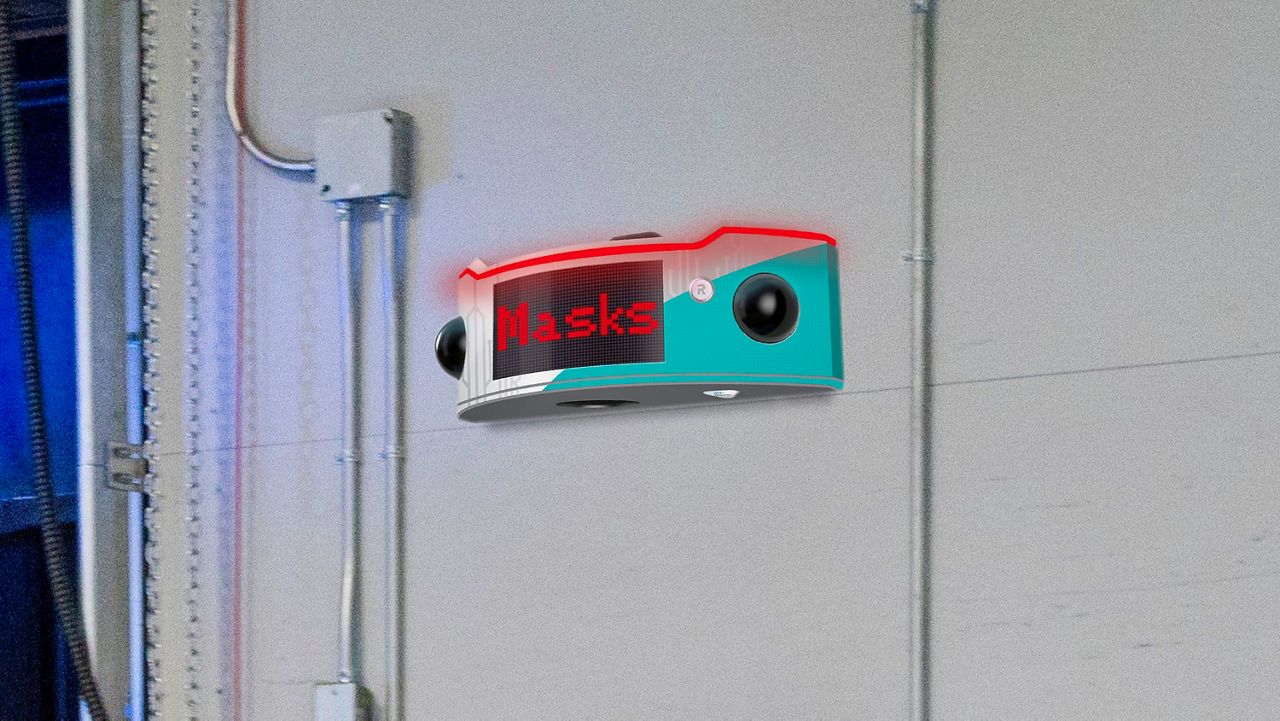LAGUNA NIGUEL, Calif. — Steve Reinharz is back where he started – inside a garage.
Reinharz, a Laguna Niguel resident, is the president of Robotics Assistance Devices (RAD), an automation, artificial intelligence, and robotics manufacturer with offices in Orange County and Corona.
Since the beginning of the coronavirus pandemic and with the company having some high-risk employees, he and a few workers have been working in one of his employee’s garages in Tustin and Mission Viejo.
And it is inside these garages that Reinharz and his team are developing a new device that can detect, alert and hopefully remind a maskless person to wear a mask before entering a business or facility.
“[The coronavirus] has given us an opportunity to create new solutions,” Reinharz said. “Facemask detection and autonomous response analytic is one of the solutions.”
The new robotic device in the market highlights how companies are creating new technology and innovation for businesses as they adapt to a new world dealing with a global health pandemic. For the past couple of months, some hotels have upped orders on delivery robots for room service to provide contactless guest experience. Other robotic companies have focused on developing robots for enhanced sanitization and cleaning.
“In times of trouble, technology solutions are more readily adopted by companies because there is more cost-saving and to try new things especially touchless and remote devices,” Reinharz said.
A device that detects people wearing masks is a sure sign of the times. For the past several months, the Centers for Disease Control and Prevention and state health agencies have recommended people practice social distancing and wear a mask in public to slow the spread of the coronavirus, which has claimed more than 181,000 lives as of Thursday. Many businesses have made it a requirement for people to wear masks in their establishments.
However, wearing or not wearing a mask has become a political and contentious flashpoint. Some groups and individuals have rallied against wearing masks with some anti-maskers throwing public fits and meltdowns. In some rare cases, violence has erupted between masks and anti-mask wearers. Anti-mask wearers believe masks are not effective against the coronavirus and can jeopardize their health or are just not comfortable to wear.
“There are a lot of rebellious people out there,” Reinharz said.
Founded in 2016, RAD has developed a handful of robotic and artificial intelligent security devices for building owners. The company’s robots have been deployed at facilities across 15 states, he said.
One of RAD’s newest devices is the Responsive Observation Security Agent or ROSA, a mounted artificial intelligent face mask recognition unit. Like an outdoor LED sign, the device is equipped with a small camera and can be placed on the front of a store or building’s wall or a pole. When a maskless person is about to enter a facility, it will notify the building’s security staff, flash bright lights, and send out a loud audio alert reminding them to wear a mask.
The device can detect every type of face mask from medical masks, scarves to gaiters.
The goal of the device, which is a $750 a month subscription service, is to remind people to wear masks, especially during the health pandemic, and, most importantly, to prevent confrontation with other humans, Reinharz said.
“I call it soft behavioral change reminders,” he said. “The point here is to be non-confrontational and to be non-bias and to remind people to wear a mask.”
Reinharz said the system can’t physically prevent someone from not wearing a mask into a building. But instead, it would set off a type of alarm.
“If you do [walk into a store without a mask], you’ll see the visual and audible reminder [to wear a mask], which is broadcast, so everybody is going to look at you. That’s where the peer pressure behavior changes,” he said.
He added that every incident of a maskless person walking into a store is recorded and sent to the store’s manager or security staff. It will be up to each store’s policy to escalate the situation and send the information to law enforcement.
“We are trying to create circumstances whereby that [anti-mask wearing] person will leave, and if they don’t leave, then we have a sequence of events that will happen involving humans,” he said.
With a device that can recognize faces, critics may see this type of facial recognition and information collection as a breach of privacy. Reinharz dismissed those claims.
“In public spaces, there are no privacy rights,” he said, adding that a person could encounter as many as 70 security cameras on any given day. “On private property, company owners have the right to perform reasonable actions to protect their property.”
And what happens if someone throws something or uses a baseball bat to break the ROSA device? Reinharz said he hopes that happens.
“It just means whoever was angry enough to take a bat to an inanimate object could possibly have done that to a human being,” he said. “You can beat up my devices all day long. We’re here to help humans avoid that kind of battery.”
He added that if a device does break, his company will replace it for free.
Reinharz said that he is happy so far with the development of ROSA and his other security devices. It pairs nicely with another of RAD’s devices that provides health screening workers.
He said so far the ROSA devices have received a lot of interest from companies. The company will deploy ROSAs at a high-end national grocery store and two Class A commercial buildings, he said.
He said it takes three days to build a ROSA unit and that he’s having a blast putting it together with his employees inside a garage, just like the old days.
“We started four years ago in one of my guy’s garages, and we’re right back in his garage,” he said.



